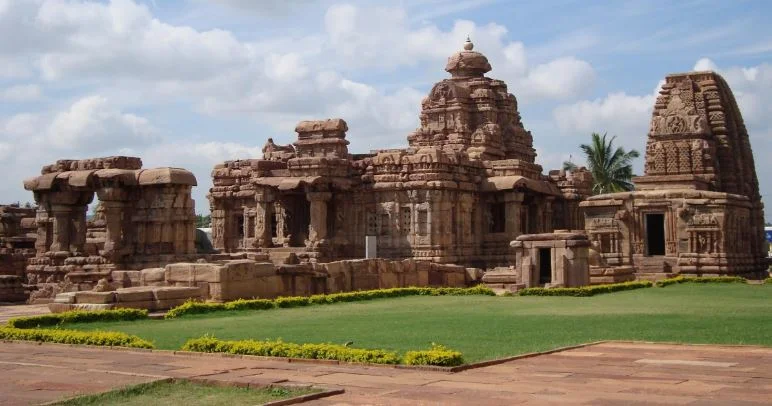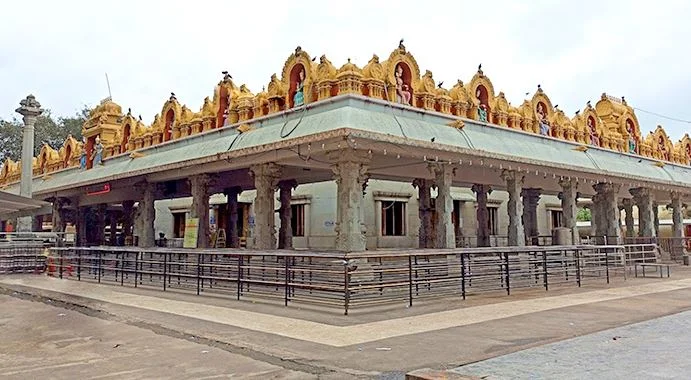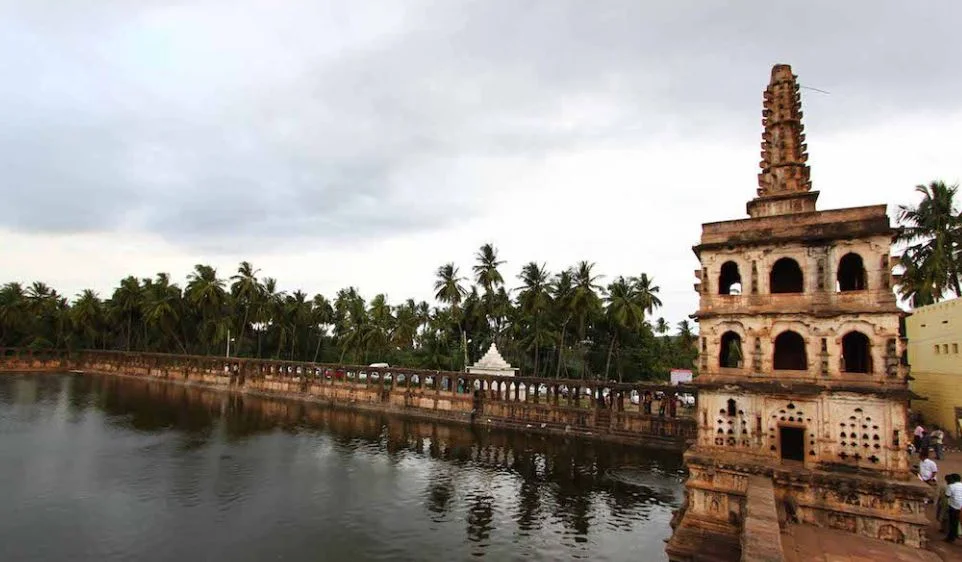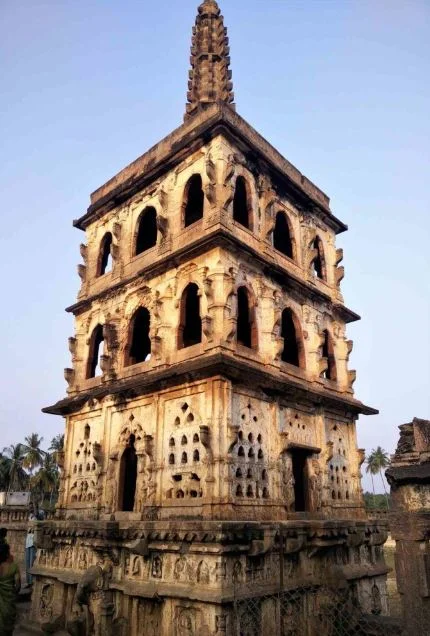Banashankari Amma Temple is a revered Hindu temple dedicated to Goddess Banashankari, an incarnation of Goddess Parvati. Here are 15 facts about Banashankari Temple
Banashankari Temple is located in the village of Cholachagudd near Badami in the Bagalkot district of Karnataka, India. The temple holds great religious significance and is considered one of the ancient and prominent temples in Karnataka.
The temple complex features a unique architectural style, showcasing intricate carvings and sculptures. The main sanctum of the temple is believed to be a cave, and the goddess is worshipped in the form of a stone idol. The temple also houses smaller shrines dedicated to other deities, including Lord Ganesha and Lord Hanuman.
Devotees visit the Banashankari Temple to seek blessings, fulfill their wishes, and find solace. The temple attracts a large number of devotees, particularly during the annual Banashankari Devi Fair, which is held during the months of January and February.
Facts About Banashankari Amma Temple
Here are 15 interesting facts about Banashankari Amma Temple.
1. About Banashankari Temple
Banashankari Temple, also known as Banashankari Amma Temple, is a revered Hindu temple located in Badami, Karnataka, India.
- The temple is dedicated to Goddess Banashankari, an incarnation of Goddess Parvati and a revered deity in the region.
- It is believed to be one of the oldest and most significant temples in Karnataka, with a history dating back centuries.
- The temple is an important pilgrimage site attracting devotees from different parts of the country.
Banashankari Temple holds immense religious and cultural significance in the local community.
12. Historical Facts About Banashankari Temple

The temple is believed to have been built during the Chalukya dynasty in the 7th century. It is situated on the banks of the Banashankari River, surrounded by scenic natural beauty.
The presiding deity, Goddess Banashankari, is depicted with eight arms, holding various weapons and blessings.
Banashankari Temple has a rich historical significance and has witnessed the rise and fall of various dynasties.
- It has been patronized by different rulers, including the Chalukyas, Rashtrakutas, and the Vijayanagara Empire.
- The temple’s architectural features and sculptures reflect the artistic styles prevalent during different periods.
- The historical relevance of Banashankari Temple adds to its cultural heritage and attracts history enthusiasts and scholars.
Archaeological studies and excavations in the surrounding areas have revealed ancient artifacts and structures of historical importance.
2. Legend and Mythological Facts About Banashankari Temple
According to mythology, the Banashankari Temple is believed to have been established by Goddess Parvati herself.
It is said that she appeared in the form of Banashankari to protect the local people from demons and evil forces.
The temple’s origin is associated with the mythological tale of the churning of the ocean (Samudra Manthan) by gods and demons.
Banashankari Temple is considered a Shakti Peetha, a sacred site where the body parts of the goddess Sati (Parvati) fell after her self-immolation.
The temple’s mythology and legends add to its spiritual aura and attract devotees seeking the blessings of the divine goddess.
3. Architectural Facts About Banashankari Temple

Banashankari Temple exhibits the Chalukyan architectural style, reflecting the rich historical and cultural heritage of the region.
- The temple features a distinctive Dravidian-style gopuram (tower) at the entrance, adorned with intricate carvings and sculptures.
- The main sanctum of the temple is built in the shape of a Greek cross, known as a cruciform plan, with a central dome.
- The temple complex also includes pillared halls, courtyards, and other smaller shrines dedicated to various deities.
The architectural splendor of Banashankari Temple showcases the craftsmanship and skill of the ancient artisans.
4. Navaratri Festival
The Navaratri festival is one of the most celebrated events at Banashankari Temple.
It is a nine-night festival dedicated to the worship of Goddess Banashankari.
The temple becomes the center of festivities, with elaborate decorations, cultural performances, and religious rituals.
Devotees throng the temple during Navaratri, seeking the blessings of the goddess and participating in traditional rituals and prayers.
The festival creates a vibrant atmosphere of devotion and celebration, attracting people from far and wide.
5. Banashankari Jatre
Banashankari Jatre is an annual fair and procession held at Banashankari Temple in the month of January or February.
The fair is a grand celebration, attracting thousands of devotees and visitors.
The highlight of the Jatre is the colorful procession of the goddess’s idol carried in a beautifully decorated chariot.
The procession is accompanied by music, dance, and traditional performances by local artists.
The Banashankari Jatre provides a platform for cultural exchange, religious fervor, and community bonding.
6. Where is Banashankari Temple Located?
Banashankari Temple is situated on the outskirts of Badami town, in the Bagalkot district of Karnataka.
- It is located on the banks of the Malaprabha River, which adds to the natural beauty and serenity of the temple surroundings.
- The temple’s location amidst hills and lush greenery provides a tranquil setting for devotees and visitors.
- The scenic beauty of the area makes it an ideal spot for spiritual retreats and connecting with nature.
The temple’s location also allows for panoramic views of the surrounding landscape, offering a visual treat to visitors.
7. The Banashankari Temple Complex
The Banashankari Temple complex encompasses more than just the main shrine.
It includes various structures and amenities to cater to the needs of devotees and visitors.
The complex features separate halls for conducting religious ceremonies and rituals.
Facilities such as restrooms, cloakrooms, and seating areas are available for the convenience of visitors.
The temple complex also houses shops and stalls selling religious items, souvenirs, and Prasadam (sanctified food offerings).
8. Banashankari Temple’s Rituals and Prayers
Daily rituals and prayers are performed at Banashankari Temple to invoke the blessings of Goddess Banashankari.
- The temple priests conduct multiple pujas (rituals) throughout the day, following ancient Vedic traditions.
- Devotees can participate in these rituals and offer prayers to the goddess.
- Special festivals and auspicious occasions witness elaborate ceremonies, including Abhishekams (ritual bathing of the deity) and Aaratis (waving of lamps).
The rituals and prayers at Banashankari Temple provide a spiritual atmosphere for devotees to connect with the divine.
9. Cultural and Educational Initiatives
Banashankari Temple is not only a place of worship but also a hub of cultural and educational activities.
- The temple promotes the preservation and propagation of traditional art forms, music, and dance through various initiatives.
- Cultural events, music concerts, and dance performances are organized to showcase the region’s rich artistic heritage.
- The temple also provides a platform for artists, musicians, and scholars to exchange knowledge and foster cultural awareness.
- Educational programs, seminars, and workshops on Hindu philosophy and spirituality are conducted to disseminate spiritual wisdom.
10. Festive Facts About Banashankari Temple
Banashankari Temple celebrates several festivals throughout the year, attracting devotees and visitors.
Apart from Navaratri and Banashankari Jatre, other important festivals include Maha Shivaratri, Diwali, and Durga Puja.
During these festivals, the temple is adorned with lights, flowers, and festive decorations.
Devotees gather in large numbers to participate in the festivities, seek blessings, and immerse themselves in the divine aura.
The festive celebrations at Banashankari Temple are a blend of religious rituals, cultural performances, and joyous gatherings.
11. Annadanam (Food Offering):
Banashankari Temple provides Annadanam, the act of offering free food to devotees and visitors.
The temple serves meals to thousands of people every day, irrespective of caste, creed, or religion.
Annadanam is considered a noble act of service and is believed to bestow blessings and spiritual merit.
Volunteers and donors contribute their time and resources to support the Annadanam program at the temple.
The initiative ensures that no one goes hungry and exemplifies the principle of selfless service and compassion.
13. Religious Significance
Banashankari Temple holds immense religious significance, particularly for devotees of Goddess Banashankari.
It is believed that worshiping the goddess with devotion can fulfill desires, bring prosperity, and grant protection from evil forces.
Devotees believe that the goddess’s blessings can heal ailments, remove obstacles, and provide spiritual guidance.
The temple is regarded as a sacred space where devotees can seek solace, offer their prayers, and surrender to the divine mother’s grace.
The religious significance of Banashankari Temple makes it a cherished pilgrimage destination for devotees seeking spiritual solace.
14. Places to Visit near Banashankari Temple

The area around Banashankari Temple is home to several other attractions that visitors can explore.
- The Badami Cave Temples carved out of sandstone cliffs, are a UNESCO World Heritage Site located nearby.
- The Agastya Lake, situated close to the temple, offers a serene and picturesque spot for boating and relaxation.
- The Archaeological Museum in Badami showcases ancient artifacts and sculptures, providing insights into the region’s history.
- The nearby Pattadakal and Aihole are famous for their temple complexes and architectural marvels, making them popular tourist destinations.
Visitors to Banashankari Temple can combine their spiritual journey with visits to these fascinating sites, enriching their overall experience.
15. Community Services
Banashankari Temple actively engages in community services and welfare activities.
The temple conducts health camps, blood donation drives, and medical check-up programs to serve the local community.
Educational scholarships and financial aid are provided to deserving students to support their academic pursuits.
The temple also contributes to social initiatives such as providing relief to disaster-affected areas and supporting orphanages and old-age homes.
These community services reflect the temple’s commitment to the well-being and upliftment of society, embodying the spirit of compassion and service.
How to Reach Banashankari Amma Temple?
The village of Cholachagudd is well-connected by road and can be easily reached from nearby cities like Badami and Bagalkot. The serene and peaceful ambiance of the temple, along with the natural beauty surrounding it, creates a spiritual atmosphere for devotees and visitors.
Related Posts
- 21 Facts About Vaishno Devi
- 19 Facts About Amarnath
- 21 Facts About Kedarnath
- 27 Facts About Badrinath
- 16 Facts About Gangotri
- 17 Facts About Yamunotri
